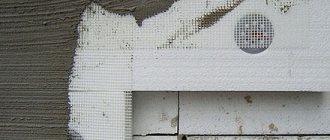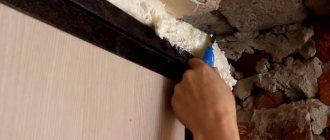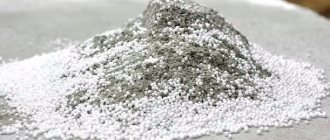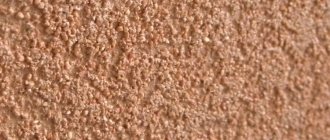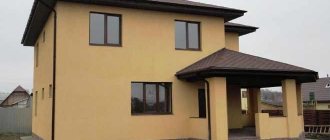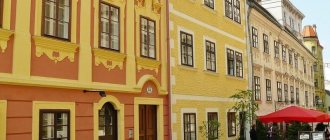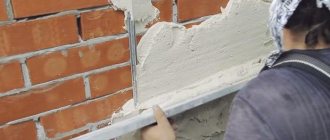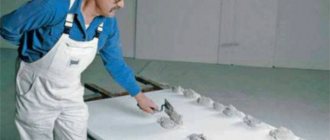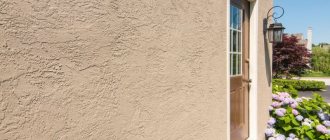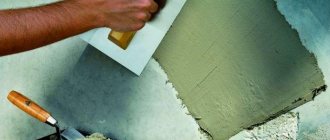Why is it necessary to plaster polystyrene foam?
Plaster will protect the material from destruction
Plaster is an important element of protective treatment. The technology for carrying out the work in this case differs in a number of nuances from conventional plaster. Polystyrene foam is characterized by a porous structure. This material is produced by filling styrene granules with gas under high pressure and heating with water vapor. Exposure to high pressure and temperature leads to swelling and sticking of granules together.
Afterwards, the mass of the resulting substance is pressed, giving it the shape of slabs. The thermal insulation properties of the resulting material are high, but it impairs natural ventilation in the house. Low cost relative to other insulation materials and low weight allow you to put up with its low strength.
As a result of atmospheric influences (ultraviolet radiation, humidity, temperature fluctuations), the bonds between individual granules weaken over time. The slab begins to crumble and may fall apart into pieces.
Due to these phenomena, it is necessary to apply a plaster coating to polystyrene foam. It plays a role protecting against negative influences.
Along with conventional polystyrene foam, the use of fire-resistant and extruded types of polystyrene foam is common in practice. The latter is the most advanced version of the material in the form of a single substance (rather than individual granules) with a strong connection of molecules. The absence of micropores prevents steam and water from penetrating into the structure. The negative effects of the atmosphere can be traced only on the surface, but also in places of cuts, so the use of extruded polystyrene foam is more preferable in the long term.
Which plaster to choose
When choosing a plaster composition, first of all you need to take into account the characteristics of the foam. This material is not durable, so the protective coating must be sufficiently dense and resistant to mechanical stress. Also, the plaster mixture must have high adhesion to the base, since the foam has a smooth surface. In addition, you need to choose a plaster that is moisture-resistant, plastic, easy to apply and not prone to cracking. But the vapor permeability of the composition is not of great importance, since the vapor permeability of the insulation is very low.
A conventional cement-sand mixture only partially meets these requirements, and it is not advisable to use it on foam plastic. Of course, this is the most budget-friendly composition, but within a year the facade will be covered with small cracks and everything will have to be redone. Therefore, for finishing on foam plastic, it is recommended to use only factory-made plasters containing special additives.
Cement-sand plaster
- Mineral plasters – the most popular option in terms of price-quality ratio. They are made on the basis of white cement, containing lime hydrate and mineral chips as a filler. They go on sale in the form of a dry powder, which must be diluted with water in a certain proportion before starting work. Such plasters perfectly withstand the effects of precipitation, temperature changes, and have good adhesion. True, they have a short service life - only about 10 years, and low ductility, as a result of which the plaster cracks when the building shrinks.
Mineral plaster
Decorative mineral plaster, shades
- Acrylic plasters – ready-made plastic mixtures based on acrylic resin. They contain mineral binders and various additives that increase the performance characteristics of the coating. These plasters are not prone to cracking, withstand temperature changes and the negative effects of precipitation, and are highly durable. The service life of acrylic coating is from 15 to 25 years. The disadvantages of this type of mixtures include high price and tendency to burn out.
Acrylic facade plaster
What is good about acrylic plaster?
The range of plasters for foam plastic is quite large, but there are brands that are in particular demand: Ceresit, Stolit, Osnovit, Knauf, Ecomix. Manufacturers produce several types of formulations:
- for attaching insulation to the base;
- to create a leveling layer;
- universal.
It is best for a novice master to choose a universal type of plaster that can be used at all stages of finishing with equal efficiency. But even if you prefer to use separate compounds for each process, they should all be from the same manufacturer, and preferably from the same line.
Other gluing methods
Some craftsmen try to use “homemade” methods for attaching polystyrene boards using other methods. This is not always reasonable.
Polyurethane foam
Foam is used to fasten any surface, including EPS. The cost of foam is often cheaper than similar glue in cans. But the disadvantages of this method are obvious:
- slow setting with the base - slabs lying vertically will constantly slide;
- the glue contains special adhesion-improving additives, which makes it more reliable for tearing than foam;
- polyurethane foam tends to grow in volume, and when constructing polystyrene foam this can play a bad role;
- foam peels off the wall faster than glue.
We recommend: Primer for plywood - features of choice
The advantage of foam is the ability to fill the seams between the slabs, so it can also be useful in installation.
Hot melt adhesive
Thermoplastic adhesives include special substances based on polyamide, ethylene vinyl acetate, which become liquid when heated. As they cool, they harden. Such products are suitable for working with extruded polystyrene foam, but their cost per 1 kg can be up to 1,500 rubles. The price of the work, therefore, will not be the lowest. It is more expedient to buy suitable specialized glue and carry out repairs economically, efficiently and reliably.
Why is polystyrene foam plastered?
Plastering the facade will protect the material from mechanical damage
Finishing polymer coating solves a number of problems:
- Protects the insulation surface from accidental mechanical impacts.
- The finish acts as a barrier to moisture penetration into the polymer. When left in a humid environment for a long time, the foam, saturated with moisture, loses its thermal insulation qualities.
- The finishing blocks access to ultraviolet rays to the surface of the polymer. Under the influence of UV radiation, the structure of the material is destroyed.
- In the event of a fire, the foam becomes an obstacle to the further spread of fire. The polymer burns only when exposed to very high temperatures.
Advantages and disadvantages of polystyrene foam when insulating a house
In polystyrene foam, the bulk of the material is gas. This determines its main advantages: light weight and good thermal insulation properties. Polystyrene foam is also a good sound insulator, since its structure dampens sound vibrations. In addition, the advantages of the material include:
- environmental friendliness - complies with environmental standards and does not harm humans and the environment;
- durability - resistant to mold, rot and corrosion;
- light weight - easy to transport, no additional load on the foundation;
- ease of processing and installation;
- affordable price.
We recommend: English style armchairs: luxury and comfort
In addition to the advantages, there are also disadvantages:
- Low strength. This is the main reason why the insulation layer is covered with additional material, since under mechanical stress its structure is easily damaged and it loses its thermal insulation qualities.
- Incompatibility with nitro-based paints and varnishes. These substances can corrode the foam mass.
- Does not allow air to pass through. Poor vapor permeability does not allow its use in interior decoration of residential premises. Without good ventilation, the house turns into a thermos.
- Rodents and insects are partial to foam that is not protected by plaster or a durable finish.
- Fire hazard - burns and releases hazardous substances.
Types of plastering materials
This material requires the selection of a special plaster composition. Not all plasters are suitable for polystyrene foam. Some options contain components that destroy the foam immediately. Therefore, in the store, be sure to check with the consultant whether the composition will be suitable for work on this insulation or not.
Mineral
The most affordable option. It consists of cement, sand and mineral fillers that improve the properties of the layer after hardening. It is sold in the form of dry mixtures, which must be diluted with water in a certain ratio before starting work. The manufacturer must indicate the proportions on the packaging.
It is quite possible to make such a solution yourself. In this case, sand and cement are purchased separately and during the preparation process the required volumes of each component are measured separately. So, it’s more difficult to work, especially if you need to prepare half a portion to finish a small area.
Mineral plaster is of lower quality. Difficulties arise during application, since it has poor adhesion with polystyrene foam. To increase adhesion, the insulation is treated with a special primer and small cuts are made across the entire surface.
Acrylic
A more expensive option for plaster mixtures, but at the same time higher quality. This type of plaster on polystyrene foam does not require special preparatory work, since it has high adhesion rates to any materials.
The main components are acrylic resins along with chemical additives. Such mixtures were created exclusively for finishing facades after insulation. Therefore, it can withstand various loads well. The treated surface remains attractive for a long time and is easy to clean.
Using acrylic plaster, you can create textures or immediately use decorative compositions. For example, the “bark beetle” has inclusions that, after rubbing, form grooves. Using different grouting techniques you can create an original design.
Step-by-step instruction
After the penoplex is glued and secured with dowels, you can begin applying facade plaster. When a person is applying plaster for the first time, he needs to try it on some surface. For example, on the remaining sheet of penoplex. Then you can understand how comfortable it is to hold the instrument.
Kneading the mixture
It is very important to approach the first stage responsibly. You need to prepare the mixture according to the instructions, which must be on the package. If you are doing this kind of finishing for the first time, do not prepare a large volume at once. The solution hardens quite quickly, and if you don’t have time to handle it, you’ll just have to throw it away.
To secure the reinforcing mesh, professionals recommend preparing the solution a little thinner than indicated on the package. Then you can slightly reduce the material consumption, and the mesh will be fixed much easier.
Installation of reinforcing mesh
First you need to cut the mesh into small pieces 30 cm wide. I fold them in half. These pieces will be used for laying on the corner, or you can buy ready-made corners with a mesh at a hardware store. It is from the corner of the house that they begin to install the reinforcing mesh on the penoplex.
After this, you can begin finishing. On both sides of the corner, at a distance of 15 cm, apply a plaster solution. The thickness should not exceed 3 mm. Then the bent reinforcing mesh is laid. It needs to be smoothed with a spatula and pressed a little into the solution. You need to move from the corner, starting from the top. The slopes of windows and doors are processed in the same way.
Then they work on the surface of the wall. A layer of solution is also applied that will correspond to the width of the mesh. Then the reinforcing layer is laid. Each piece should overlap the previous one, by 5–8 cm. Smooth the surface with a spatula and press the mesh. On a flat surface, move from the center of the piece.
How to align a layer
To create a final even layer you need to do a few more manipulations.
- About a day after completing the installation of the reinforcing mesh, you need to sand the surface. This is exactly how long it takes for the layer of plaster to dry well.
- A grater with sandpaper removes unevenness that could have formed when smoothing the mesh with a spatula. You need to rub in a circular motion with slight pressure.
- Then you need to apply a layer of primer. There is no need to skip this step. The primer will help the dried layer of plaster and the finishing layer adhere more firmly. In addition, if you choose antibacterial and antifungal properties, you can protect the coating from the effects of microorganisms.
- Now apply a leveling layer. The mixture is prepared according to the instructions. Apply with a large spatula, no more than 3 mm thick. Individual sections should not coincide with the joints of the reinforcing mesh.
- Then the layer is left to dry for 1–3 days. Drying time depends on the mixture itself and weather conditions. If the ambient temperature is high, it will dry out faster.
- Then you need to use the grater again. Remove small bumps and depressions.
Finishing
If you get a perfectly smooth wall surface and this texture suits the owner of the house, then you can leave this façade. To give it a more attractive look, you can use acrylic paint. A wide color palette will allow you to turn your wildest ideas into reality. But you can create a more original surface of the facade walls. Special decorative plasters are sold for this purpose. They are applied in a thin layer, and the texture is created by small inclusions.
You can also use a regular plaster mixture and special texture tools (roller, sponge, spatula or improvised materials). The texture is created from the raw surface, both with decorative compositions and with ordinary ones. After hardening, it will no longer be possible to create a drawing.
Features of styrofoam plaster
We have already become familiar with the first feature - the existence of special mixtures. The second feature is foam plastering. This work is carried out using reinforcing mesh. Without it, sufficient mechanical strength of the soft EPS coating is unlikely.
The third “strange thing” is that the surface of the insulation boards is not coated with a primer. Plastering on polystyrene foam is a fairly simple but effective job. The materials are cheap and easy to use.
There are also some nuances when plastering internal thermal insulation and facades.
You cannot plaster polystyrene foam with ordinary cement compositions with sand. Cement corrodes PPS
Along the façade
With the beginning of the use of polystyrene foam, the development of buildings in which the cladding was made of different materials appeared.
The most successful technology is called “wet facade” - the construction of a multi-layer “pie” in which the materials of each layer perform their function:
- façade primer for plaster;
- adhesive plaster mass;
- layer of sheet insulation;
- plaster (adhesive) solution;
- reinforcing mesh;
- leveling plaster layer;
- primer layer;
- finishing coating.
External cladding with foam plastic is the most reasonable and correct solution, since in this case:
- The dew point (the place where condensation forms) is taken outside the room, located inside the sheet insulation, where there is nothing for condensation to form from.
- In this case, the room also does not lose its volume.
- Heat accumulation occurs and the rooms cool down much more slowly.
However, there are cases when it is not possible to place foam sheets under the façade plaster.
Indoors
Insulation and plastering of walls using polystyrene foam indoors is used if:
- it is impossible to get close to the wall from the outside, for example, there are other buildings nearby, or this is insulation and plastering of a balcony (loggia) located at a high altitude;
- the building is recognized as a historical monument;
- prohibited by the rules for decorating houses in the center of a populated area.
In addition, foam plastic inside the house may be needed to insulate the slopes of the front door, and also if it is not possible to insulate the slopes of the apartment windows from the outside.
When insulating walls inside a building, the preparatory work is carried out in the same way as before conventional plastering. Then foam plastic is glued, a mesh is attached and plastered in the same way as on the facade. The difference here may be the finishing stage; if the walls are painted or wallpapered, a particularly smooth surface is required. Putty is applied to the leveling plaster layer applied to the PPS, then dried.
Features of this finish
It is difficult to apply plaster on this insulation for the following reasons:
- smooth surface - the solution can slide; if you manage to apply it, it can crack or fall off after drying;
- lack of hygroscopicity - moisture from the plaster solution is not absorbed into the polystyrene foam, but remains in the finish, which significantly extends the drying time;
- the difference in the thermal expansion values of the insulation and finishing material, which causes cracking of the latter.
To avoid such problems, you should carry out preparatory work and do everything as clearly and correctly as possible:
- Walk along the surface of the polystyrene foam with a needle roller or make cuts with a sharp knife. This creates depressions where the solution can “catch.”
- Be sure to coat it with a primer that increases adhesion.
- There is no way to do without a mesh for reinforcement.
- The maximum thickness of the applied layer cannot exceed 5 mm.
Such recommendations will help reduce the risk of cracks and simplify the process of applying the plaster solution.
The process of plastering foam plastic: stages of work
There are several steps to follow. But first you will need to prepare the tools: a plaster grater, a drill with a mixer, a painting mesh, a building level, sandpaper for grouting, a spatula and a trowel. Consumable materials will require plaster mixture, primer, decorative plaster (mineral or acrylic). Now you can move on to the work itself.
Plastering foam plastic: stages of work
Tools and materials for work
You should prepare in advance:
- short-haired roller (needed for priming);
- construction mixer;
- spatulas with a metal plate;
- trowel or trowel;
- plastic grater with sandpaper attached;
- plastic corners with reinforcing mesh;
- notched spatula;
- scissors for cutting mesh;
- level;
- containers for solution and water;
- brush;
- plaster mixture (or several types);
- primer;
- fiberglass mesh;
- masking tape.
Plastering materials are purchased in a volume sufficient to carry out the entire work (with a reserve). You should purchase products from the same company, preferably from the same batch (this is especially important for decorative color compositions).
We recommend: Construction of wooden floors between floors: detailed technology
It is better to take a trowel and spatula with rounded corners. This is especially important for applying decorative plasters.
Leveling the base
Before you putty the foam base, you need to carry out some preparation. Initially, you need to level the level of all joints between the panels, for which you use a rule or a wide spatula. Such differences must be eliminated first, since this defect cannot be eliminated using mixtures.
The joints are removed using polyurethane foam. This material allows you to achieve maximum tightness. As soon as the foam has dried, its excess is cut off with a stationery knife. After this, the surface is cleaned of dirt and passed several times with a needle roller. Thus, the adhesion of materials is increased and the mixture will adhere better to the foam.
Sealing joints and seams
Preparation of the solution
For beginning builders, it is better to pay attention to universal mixtures (glue-plaster). This solution is used both for fixing foam plastic to the wall and for plastering. The companies Ecomix and Ceresit have proven themselves to be excellent.
For processing 1 sq.m. the surface requires approximately 4 kg of mixture. Each package contains instructions from the manufacturer. For this stage, any plastic or metal container is used, and the stirring itself is best done using a drill with a “mixer” attachment. This will not only create a uniform consistency of the solution, but will also significantly save effort and time on mixing.
Advice! Professional craftsmen recommend preparing a solution of a thinner consistency for gluing the reinforcing mesh than that specified in the instructions. This will allow all pores on the foam to be treated, and therefore increase the adhesion of materials.
Preparing the base
Responsible stage. The evenness and service life of the plaster “shell” depend on the quality of the work performed.
Before gluing the insulation sheets, the wall is prepared as usual:
- remove unusable old coating, knock down large protrusions;
- chips and cracks are “healed”;
- clean the base from stains of various origins (wash with water, dry, treat with special means);
- Dust is removed from the surface, remaining metal objects are insulated with oil paint;
- install the base profile according to the level;
- install foam sheets (using glue and fastening with dowels).
Sequence of preparation of the foam base:
- check the evenness of the entire surface (joining sheets of PPS must be at the same level) by running a rule along the wall;
- the protrusions are carefully cut off, the joints are cleaned with sandpaper;
- remove dirt and dust from the surface;
- To increase adhesion, the top of the foam plastic is rolled with a needle roller (the solution will penetrate into the holes formed during plastering).
Beginners often wonder: is it necessary to prime the foam before plastering? If plastering is done with special mixtures for PPS or mixtures from Knauf, then no primer is required.
But where mechanical loads can be increased (to the height of a person’s height), a primer for foam plastic will not be superfluous. You can cover the walls themselves with concrete contact or Ceresite. After plastering (for finishing), the insulated wall is primed.
Installation of plaster mesh
In order for the plaster to adhere securely to the foam, a reinforcing mesh is pre-installed on it. This layer provides protection against cracking and provides additional surface strengthening.
It is best to purchase dense meshes, since the mixture holds more securely on them. The best option is a mesh with a density of 130-160 g/sq.m., moreover, it must be resistant to alkali, which is present in the mixtures.
But you need to know how to apply such material to the corners correctly. The work has the following sequence:
- the mesh is cut into strips of 1 m, with a width of 30 cm;
- a bend is made exactly in the middle of the segment, which will be used to insert the tape into the corner;
- using a wide spatula, apply the solution to an angle in accordance with the length of the tape, but at the same time apply the mixture along the width an additional 5 cm on each side to create an overlap;
- the segment is applied to the treated surface and smoothed with a spatula (direction - from top to bottom and from the center to the edges).
Processing external corners
Processing the remaining sections of the walls occurs in a similar way. Since the mixture dries quickly, it is recommended to apply it in small areas - 90x100cm. A mesh is placed over the mixture and processed with a spatula so that it sinks into the solution. If this does not happen, then it is permissible to apply more putty on top. The mesh is installed with an overlap.
Closing seams
The seams between the EPS sheets must be filled with polyurethane foam to prevent the formation of cold bridges. If the mounting foam at the joints protrudes above the EPS, it is cut off (the seams must be completely filled). If the seams are large, they are filled with strips of polystyrene foam of the required width, placed on the foam.
Grouting stage
Each putty has its own drying time, which is indicated by the manufacturer on the packaging - 3-4 hours in summer, 20-24 hours in winter. Using sandpaper or a plastic grater, treat all surfaces.
Grouting is carried out in a circular motion - counterclockwise. If the sandpaper comes into contact with an area with undried mixture, you will need to change the paper immediately.
Surface grinding
Applying primer and leveling
Next, you need to prepare the surface for the finishing coat. To do this, you can use two different mixtures or one universal one. But in the first case, before priming the surface of the foam, you need to level it.
The process will require the following steps:
- Using a spatula (35cm wide), the solution is applied to the walls - if the walls are grouted well, a layer of 2mm will be enough;
- as soon as the layer is completely dry, the surface is sanded - it is recommended to start this stage 3-4 days after puttying;
- then, using a foam rubber or fluffy (short pile) roller, apply a primer that will increase the adhesion of the materials - it is best to use a mixture with antifungal properties in order to increase the protection of the walls.
Advice! It is recommended to ensure that the joint points of the leveling layer do not intersect with the joints of the reinforcing mesh. If this condition is met, then seams will not be noticeable on the surface.
It is recommended to apply the primer in two layers, but each subsequent coat is applied only after the previous coat has dried. As soon as the priming is completed, the finishing begins.
We recommend: What can you take instead of paving slabs: variations of replacement
Decorative finishing
For external work, there are special facade plasters, which are designed taking into account that they will regularly experience temperature changes and the effects of climate change. Each manufacturer adds binders and additional components to the composition, on which the further performance properties of the plaster depend. Therefore, before puttingtying the foam, it is necessary to familiarize yourself with the filling of the selected mixture and correlate it with the climatic characteristics of the region.
Applying the final layer
Decorative plaster is applied as follows:
- the solution is prepared - if you have to work with a large area, it is best to prepare it in portions so that the mixture does not have time to harden (it is not recommended to re-dilute the plaster);
- the plaster is applied in two layers, each of which should not be thicker than 4 cm - a new layer is applied only after the previous one has dried;
- as soon as the mixture is half dry, start grouting - at this stage they begin to form a pattern on the surface.
Painting finishing plaster
Important! The selection of tools depends on the planned structure. A specially shaped roller is used for this. But texture can also be created using improvised means, for example, a notched trowel.
In order for the final stage to pass efficiently, it is necessary to carry out all the work under certain weather conditions: temperature ranging from 5 to 25 degrees, with humidity no more than 65-70%. It is advisable that there is no strong wind outside.
Plastering polystyrene foam is not such a difficult task, which can be done with your own hands. The main thing is to choose the right materials and follow all stages of the process.
Mesh reinforcement
To securely fix the decorative finishing layer, it is necessary to lay a special mesh on the surface of the insulation. For this purpose, it is recommended to choose materials with a density of 140 to 160 grams per m2.
Mesh for reinforcement
This mesh has sufficient density to obtain an even layer of plaster. Similar products can be used for pasting corners.
Installation of the mesh begins with the corners of the building, as well as slopes on window and door openings. To glue the material in these places, cut a 30-centimeter piece with a length equal to the length of the slope. We bend the strip in the middle and apply it to the corner part. After this, using a spatula, apply a universal adhesive mixture with a thickness of 2 to 3 millimeters.
At the next stage of work, it is necessary to attach the mesh to the solution and carefully press it with a spatula. The reinforced fabric is attached to the surface by smoothing from the center to the sides. To cover the rest of the surface, cut the mesh into equal pieces 1 meter in length, then apply the adhesive mixture over the area of the product and apply reinforced fiber.
We press the mesh against the wall using a spatula from the center in the upper and lower direction. We glue the materials overlapping, matching the joints by 5 centimeters. It is recommended to avoid joining the mesh to the joints of thermal insulation boards.
Next, the surface is grouted using a special trowel with an attached emery cloth. The wall treatment should be carried out using a dried adhesive solution. If in warm weather such a mixture dries within 2-3 hours, then in cloudy weather with low air temperatures, you need to wait at least a day to carry out such operations.
Surface treatment
Next, preliminary leveling of the base is carried out, which will allow you to obtain a high-quality plaster finish. The described work is carried out in the following sequence:
- Apply small portions of glue to a wide spatula;
- Apply the solution to the wall with light movements;
- After the adhesive mixture has dried, the surface is thoroughly grouted.
Plastering doorways and slopes
After replacing window or door frames, the best insulation of the openings formed between the frames and the facade will be to make slopes made of foam plastic with plastering. You can make slopes as soon as the polyurethane foam has dried.
The simplicity of the work is similar to installing drywall. Blanks are cut out of PPS sheets and glued to the wall along the perimeter of the frame (foam plastic also needs to be mounted under the window sill. When the glue dries, dowels with fungus are installed. Plastering the foam is done in the same way as described above (corners are placed on the mortar, strips of reinforcing mesh are attached, etc. .d.).
In order not to stain the frames, they are covered with masking tape before starting foam plastic work.
Consumption of façade plaster on polystyrene foam
If styrofoam plastering is done with a universal facade mixture, then the consumption per square meter will be 10 kg. Using two types - adhesive and leveling plaster, prepare 4 and 6 kg per square, respectively. The same consumption - 9-10 kg will be if a polymer composition is used. Of these, 3.5-4 kg will be needed for gluing the insulation, the rest will be needed for plastering on foam plastic. An online calculator will help you calculate the consumption of leveling plaster.
Insulating a house with polystyrene foam is becoming more popular every year. Having familiarized yourself with how to plaster polystyrene foam, what materials are better to purchase for the facade, which façade insulation is preferable to room insulation, you can easily solve many problems that arise during repairs or construction. Plastered thermal insulation will last longer if it is promptly tinted and repaired if the integrity of the “shell” is damaged. Your home will be safer, and you will be warmer and more comfortable in it.
Final works
The last stage of plastering foam plastic is the creation of a decorative layer, before applying which the rough surface is primed using a fine-pile roller.
Applying a decorative layer
“Bark beetle” or “wet” plaster technology is often used as a finishing finish. Apply them yourself using a spatula and grater. The thickness of the decorative layer depends on the consumption per 1 m2 and the size of the granules included in the mixture. The larger the granules, the thicker the finish coat will be.
The finished surface is left to dry completely, after which it is painted in the desired color.
High-quality foam plaster is the key to the durability of the coating and the preservation of the aesthetic appearance of the structure. Therefore, it is best to use special ready-made mixtures here. But if the budget does not allow you to resort to the most effective methods, then you can get by with ordinary cement-sand mortar.
The main thing in this case is to adhere to the correct technology for preparing the solution (1:3 plus 70 g of PVA glue per 10 liters of plaster), bringing it to the desired (creamy) consistency.
Application of decorative plaster
To securely attach the plaster layer, it is necessary to prime the surface. When using a primer, the base receives protection from the effects of mold and mildew, and surface adhesion increases.
The finishing mixture is applied to the facade using a wide spatula. During this work, you need to ensure that the solution is placed on the wall in an equal layer. Its value will depend on the fraction of plaster grains.
Final application of plaster
To obtain a textured surface, rollers or sponges are used. Such tools are especially effective when laying bark beetles. At the last stage of work, after the finishing layer has completely dried, the facade is painted or additional protection of the coating is done with colorless varnish.
Some nuances of the process of facade plastering using penoplex:
- It is recommended to carry out the work in the warm season at positive air temperatures;
- Plaster adheres better to the facade if a mesh with small cells was used for reinforcement;
- When finishing, you need to use plaster, adhesive mixture and primer from the same manufacturer;
- Allow some time for the individual layers to dry;
- The primer is applied using a short-haired paint roller;
The absence of a reinforcing mesh will soon lead to peeling of the plaster.
